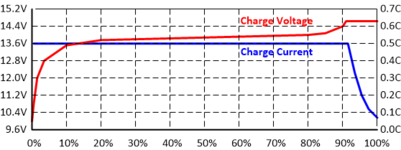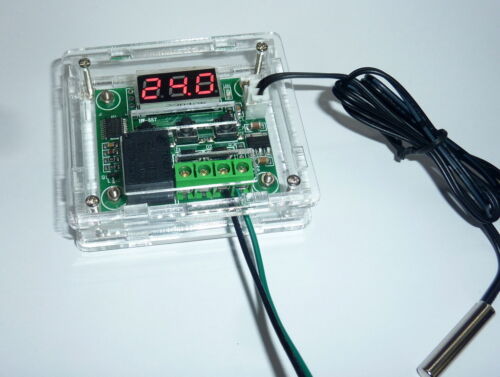Sorted now , I found this interesting info
Charging an LFP
Battery
Most regular
solar charge controllers have no trouble charging lithium-ion batteries. The Voltages needed are very similar to those used for AGM batteries (a type of sealed lead-acid
battery). The BMS helps too, in making sure the
battery cells see the right Voltage, do not get overcharged, or overly-discharged, it balances the cells, and ensures the cell temperature is within reason while they are being charged.
The graph below shows a typical profile of a
LiFePO4 battery getting charged. To make it easier to read the Voltages have been converted to what a 12 Volt LFP
battery pack would see (4x the single-cell Voltage).
 LiFePO4
LiFePO4 Charge Voltage vs. SOC
LiFePO4 Charge Voltage vs. SOC
Shown in the graph is a charge rate of 0.5C, or half of the Ah capacity, in other words for a 100Ah
battery this would be a charge rate of 50 Amp. The charge Voltage (in red) will not really change much for higher or lower charge rates (in blue), LFP batteries have a very flat Voltage curve.
Lithium-ion batteries are charged in two stages: First the current is kept constant, or with
solar PV that generally means that we try and send as much current into the batteries as available from the sun. The Voltage will slowly rise during this time, until it reaches the ‘absorb’ Voltage, 14.6V in the graph above. Once absorb is reached the
battery is about 90% full, and to fill it the rest of the way the Voltage is kept constant while the current slowly tapers off. Once the current drops to around 5% – 10% of the Ah rating of the
battery it is at 100% State-Of-Charge.
In many ways a lithium-ion
battery is easier to charge than a lead-acid
battery: As long as the charge Voltage is high enough to move ions it charges. Lithium-ion batteries do not care if they are not fully 100% charged, in fact they last longer if they are not. There is no sulphating, there is no equalizing, the absorb time does not really matter, you cannot really overcharge the
battery, and the BMS takes care of keeping things within reasonable boundaries.
Charge Voltage Needed
So what Voltage is enough to get those ions moving? A little experimenting shows that 13.6 Volt (3.4V per cell) is the cut-off point; below that very little happens, while above that the
battery will get at least 95% full given enough time. At 14.0 Volt (3.5V per cell) the
battery easily charges up to 95+ percent with a few hours absorb time and for all intents and purposes there is little difference in charging between 14.0 or higher Voltages, things just happen a little faster at 14.2 Volt and above.
Bulk/Absorb Voltage
To summarize this, a bulk/absorb setting between 14.2 and 14.6 Volt will work great for
LiFePO4! Lower is possible too, down to about 14.0 Volt, with the help of some absorb time. Slightly higher Voltages are possible, the BMS for most batteries will allow around 14.8 – 15.0 Volt before disconnecting the
battery. There is no benefit to a higher Voltage though, and more risk of getting cut of by the BMS, and possibly damage.
Float Voltage
LFP batteries do not need to be floated. Charge controllers have this because lead-acid batteries have such a high rate of self-discharge that it makes sense to keep trickling in more charge to keep them happy. For lithium-ion batteries it is not great if the
battery constantly sits at a high State-Of-Charge, so if your charge controller cannot disable float, just set it to a low enough Voltage that no actual charging will happen. Any Voltage of 13.6 Volt or less will do.
Equalize Voltage
With charge Voltages over 14.6 Volt actively discouraged, it should be clear that no equalize should be done to a lithium-ion
battery! If equalize cannot be disabled, set it to 14.6V or less, so it becomes just a regular absorb charge cycle.
Absorb Time
There is a lot to be said for simply setting the absorb Voltage to 14.4V or 14.6V, and then just stop charging once the
battery reaches that Voltage! In short, zero (or a short) absorb time. At that point your
battery will be around 90% full.
LiFePO4 batteries will be happier in the long run when they do not sit at 100% SOC for too long, so this practice will extend
battery life. If you absolutely have to have 100% SOC in your
battery then absorb will do that! Officially this is reached when the charge current drops to 5% – 10% of the Ah rating of the
battery, so 5 – 10 Amp for a 100Ah
battery. If you cannot stop absorb based on current, then set absorb time to about 2 hours and call it a day.
Temperature Compensation
LiFePO4 batteries do not need temperature compensation! Please switch this off in your charge controller, or your charge Voltage will be wildly off when it is very warm or cold.
Be sure to check your charge controller Voltage settings against those actually measured with a good quality digital multi-meter! Small changes in Voltage can have a big impact when charging a lithium-ion
battery! Change the charge settings accordingly!


